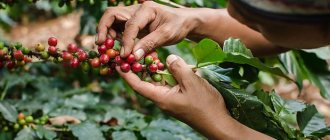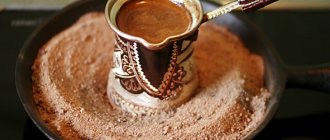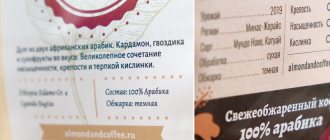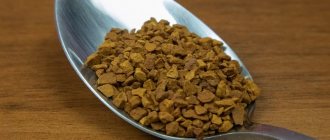Kenyan coffee grows at high altitudes
Coffee trees in Kenya grow at altitudes between 1,400 and 2,000 meters.
Here the air temperature is lower, so the coffee berries ripen slowly and develop more flavor and aromatic qualities.
The main coffee growing area is on the slopes of Mount Kenya. The soils in these regions are volcanic, fertile, rich in minerals and nutrients.
Another reason why Kenyan coffee is so popular is that the country doesn't actually produce that much coffee. Kenya has only about 150,000 hectares of land suitable for coffee cultivation in the following regions: Ruiri, Thika, Kirinyaga, Mt. Kenya West, Nyeri, Kiambu, Muranga.
Did you know that people living in these regions hardly drink the coffee they produce? Kenya is predominantly a tea country, unlike neighboring Ethiopia.
Kenyan coffee - a success story
Coffee beans came to Kenya through a complex path of religious enlightenment. A mission from one of the religious brotherhoods of that time arrived from Ethiopia to Kenya, and brought with it not only spiritual consolation, but also coffee beans. As it turns out, Kenya's soil, climate and growing conditions are conducive to the coffee industry. Very quickly, Kenyan varieties gained popularity and recognition among gourmets from different countries.
Coffee in this country is grown at significant altitudes, from 1.3 to 2 thousand meters above sea level. Unlike many African and Asian countries, the coffee production process in Kenya is not left to the will of nature. At the end of the 60s of the last century, immediately after liberation from colonial dependence, the Kenyan authorities seriously began reforming the promising coffee industry. The conducted research made it possible to identify the most successful land plots for planting trees. Technological improvements have made grain processing and drying more efficient, and the introduction of a cooperative system has made it possible to unite the efforts of small farms. The entire process of growing, collecting and processing coffee beans is strictly controlled by a special Coffee Department. Its specialists literally check every bag sent to consumers.
The distribution system for grains from this country deserves special attention. Practically, the entire harvest is sold through an auction system. Exporters, who must first obtain a special license, receive samples of the goods and then take part in auctions, buying the batches of grain they like. The highest bidder gets the coffee. Therefore, the cost of Kenyan coffee is very high. The fact that relatively few grains are grown in Kenya only adds to their value.
You won't find real Kenyan coffee in chain coffee shops. Its habitats are expensive restaurants, small luxury-segment stores, and specialized culinary portals. This exclusivity comes with serious obligations. Buyers are very demanding. Thus, recently, Kenyan coffee was subjected to very harsh criticism only because a new variety of Arabica, which was bred by local breeders, was offered for auction. The new sample was more resistant to traditional coffee diseases, gave a good harvest, but, according to buyers, it tasted worse.
Cooperative production is a guarantor of quality
Most coffee in Kenya is grown by smallholder farmers
on small family plots and undergoes further processing and preparation for sale in cooperatives. Only a quarter of production is made up of large private farms with their own processing stations.
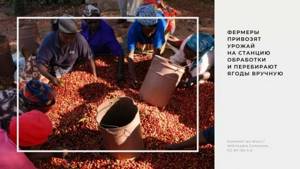
Typically, small farmers who own small plots of land hand over their harvested crops to the nearest processing stations. Before the processing process begins, the coffee cherries are carefully sorted. Only ripe red berries advance to the next stage. All work on farms and stations is done manually.
This approach guarantees stable product quality.
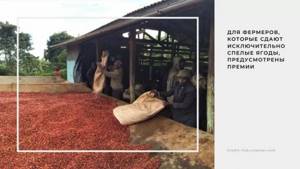
Coffee is sold at auction
In Kenya, coffee is sold through a national auction system. The coffee is put up for auction on behalf of the cooperative by marketing agents. The main buyers are large multinational companies, which then resell the lots to importers and roasters. Unfortunately, for a long time this was the only way to buy Kenyan coffee. This system was unstable, complex and completely opaque.
Recently, fortunately, positive changes have been taking place. Small importers, and sometimes roasters themselves, began buying coffee directly from auctions.
This not only helps support local, Kenyan businesses, but also makes the supply chain more stable and communication clear and efficient.
Famous Kenyan varieties
Traditionally, five different varieties of Arabica are grown in Kenya:
SL28 is one of the most famous and respected African Arabica varieties. From Kenya it spread further across the continent and into Latin America.
The SL28 variety has an interesting and long history. In 1931, researchers at Scott Agricultural Laboratories selected 42 coffee trees from different regions of Kenya and neighboring Tanganyika (present-day Tanzania) to study their yield and resistance to disease and drought. All trees were named with the prefix SL in honor of Scott Laboratories. The selection of the SL28 variety, descended from the Tanganyika Drought Resistant variety (Tanganyika Drought Resistant, the seeds of which were imported from Tanzania), gave very good results, after which the seeds began to be actively distributed among producers.
Some sources claim that Scott Laboratories crossed the French Mission, Mocha and Yemen Typica mutations to produce SL28. Whatever the exact genetic composition of this variety, their original goal was most likely to create a plant with good yield and resistance to drought and disease. Recent genetic tests have confirmed that SL28 belongs to the Bourbon genetic group.
Another distinctive feature of SL28 is the minimum required care for the plant. The tree can be left unattended for several years and then returned to successful production. In Kenya you can often find SL28 trees that are 60-80 years old and still bearing fruit.
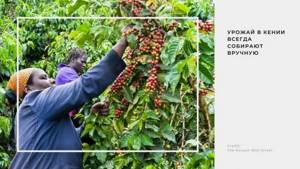
The SL34 was also developed by Scott Laboratories in the early 1930s. The variety is of original Kenyan origin, all seeds of this accession were selected from one tree of the private farm Loresho Estate in Kebete, Kenya. Research records note that SL34 is derived from the French Mission variety.
French missionaries founded a mission in Bura (Taita Hills, Kenya) in 1893 and planted the first Bourbon coffee seeds, which they brought from Reunion Island. From there, the seedlings spread throughout the country.
Thanks to the active work of French missionaries and the fact that with their help coffee seeds were transferred from Reunion Island to content, the Bourbon variety received a second stable name - French Mission.
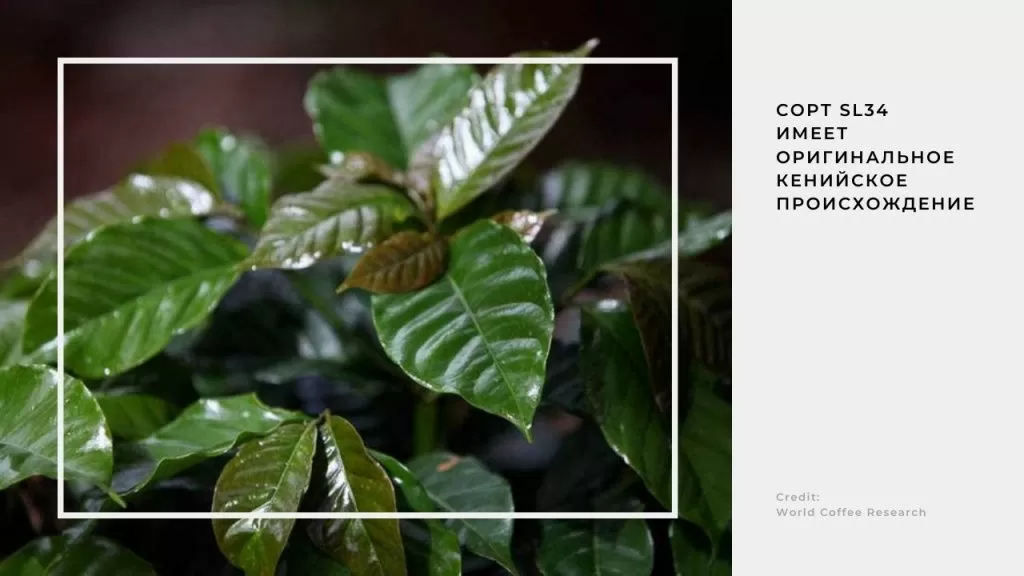
K7
was released in Kenya in 1936 after five generations of breeding SL28 and SL34. It is also characterized by low but stable productivity, high taste and aroma qualities, and, in addition, is resistant to some diseases of coffee leaves, for example, coffee “rust”. Belongs to the Bourbon genetic group.
Ruiru 11
– a high-yielding variety, resistant to disease, bred from several varieties: crossing Katimor with a hybrid of K7, SL28, N39 and Rume Sudan.
The variety owes its existence to the coffee berry disease epidemic in 1968, which led to the loss of 50% of the crop in Kenya. In the 1970s, the coffee research station in Ruiru, which gave the variety its name, began an intensive breeding program for varieties resistant to the disease. This led to the creation of Ruiru 11, released in 1985.
Batian
– an artificially bred mutation of the Ruiru 11 variety. A complex, multi-component variety. Inherits the genes of varieties SL28, SL34, Rume Sudan, N39, K7, SL4 and Timor Hybrid. Resistant to coffee rust and other diseases, developed at the Coffee Research Institute (CRI) in Ruiru in 2010.
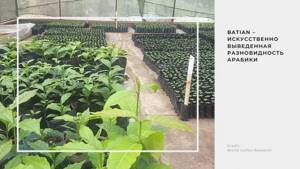
High quality coffee is washed and processed
Washed coffee is the most popular coffee in Kenya. High quality washed coffee is traditionally double fermented.
After consumption, the berries are passed through a depulpator - the pulp from the coffee berries is removed mechanically. The grains, still coated in a thin, sticky layer of gluten, are then placed in fermentation tanks with a minimal amount of water for 12 to 24 hours, depending on the rate of fermentation.
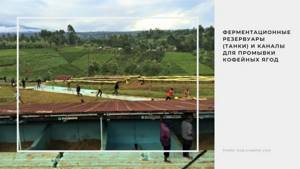
When most of the gluten has separated, the grain is washed with water. Immature grains with low density float to the surface of the water and are removed. The process is then repeated: the coffee is left to ferment for several hours and washed again with clean water. During the fermentation process, gluten is destroyed and a large amount of sugars breaks down.
This process forms the basis of the flavor of washed coffee: highlighting acidity, citrus and floral notes, creating a clean and balanced profile.
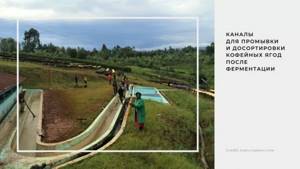
The next day, coffee beans in parchment (a thin parchment layer around the green bean, what remains after removing the berry pulp and gluten) are washed in special channels.
After washing, the parchment is laid out on tables to dry in direct sunlight, covered during the hottest hours of the day and at night. Drying takes from 8 to 14 days.
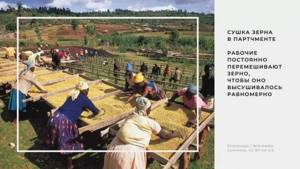
Types and varieties of Kenyan coffee
The overall flavor of the drink, obtained from Kenyan grains, is characterized by a dense, deep taste with pronounced sourness.
Fruity notes are well felt, and there may be a slight wine taste. Kenyan coffee is distinguished by its individuality, the flavors vary depending on the year of harvest, the area of cultivation, and, of course, the type of beans. The best Kenyan coffee is marked with letter combinations .
- "AA" means oblong grains of large size. They will give you a strong, aromatic drink with sharp sourness and sweetish notes, fruit or berry color.
- “AB” stands for pea-shaped Arabica beans, which grow only in Kenya. The peculiarity of Arabica is that in the vast majority of cases it has elongated grains. A type of coffee grows in Kenya that produces small, round, pea-like beans. Their taste qualities are highly valued by coffee connoisseurs for their dense and powerful taste, fruity-citrus sourness and bright, persistent aroma.
Kenyan Arabica varieties
- Ruiruiru. A unique variety, without any exaggeration. The taste of coffee is affected by the roasting time; the stronger the heat treatment, the more clearly the taste of chocolate and cherry is revealed. The average degree is considered the best; it allows you to fully reveal the full potential of the grain. The finished drink has an unusual “flaky” taste. The first sip is the sweetest, it has a caramel flavor, then notes of characteristic coffee bitterness appear, then spices and even tobacco. It is interesting that this type of coffee practically does not give any sourness, it lacks a citrus aroma, but spicy, caramel and even chocolate flavors are fully represented.
- Kenya AA Ruiruiru. Grown in a legendary place - on the slopes of Kilimanjaro. The drink has a refined taste and aroma, bread notes and citrus sourness, which leaves a subtle and long aftertaste.
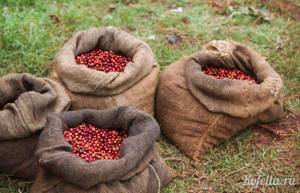
If you come across coffee labeled Kenya AA or Kenya AB, you can be confident in the quality of the future drink. Depth of taste, unforgettable sensations and genuine pleasure are guaranteed to you.
In the description of many coffee blends that are offered for mass sale or in good restaurants, you can find a mention that the composition includes beans from Kenya. This is common practice. Many blenders, as well as individual restaurateurs or renowned baristas, purchase Kenyan coffee and then add it to their own blends to impart a special taste and aroma.
You will find few traditional Kenyan recipes for making the drink. Basically, you will come across the same African and Oriental variations with spices that are passed off as ancient Kenyan traditions.
But, firstly, coffee has been grown in Kenya not so long ago that some special historical recipes have developed there, and secondly, it is grown little, and practically the entire crop is exported, so domestic consumption of coffee in Kenya is at the average level.
Most importantly, adding hot or spicy flavors can completely change the taste of the original drink. Kenyan coffee is very good in itself, so the best recipe for preparing it is the classic method of brewing in a Turk. We advise true gourmets to take care of the quality of the water; the purer it is, the better the taste of the beans is revealed.
Kenyan coffee is classified by grade
As mentioned above, at each stage of processing, coffee beans are sorted and sorted. All coffee that is exported is classified by size (grade).
It is important to say that this classification is a physical characteristic of grain that is not related to quality and taste parameters.
Kenya E
is “elephant grain”, gigantic in size.
Such batches are usually small and quite rare. Kenya AA
is the most common marking for large sizes.
The grain with the largest screen size (surface length) is from 6.8 mm. Kenya AB
is a mixture of two types of grain: category A grain with a surface length of 6.8 mm and B grain - a slightly smaller size, from 6.2 mm.
Kenya RV
- peaberry grains.
Two grains usually ripen in the berry, but sometimes only one grain develops inside the berry; it takes on a round shape and is called peaberry. Kenya C
– grains are smaller in size than category AB.
It is rare to find such a label among high-quality coffee. Kenya TT
is another small size.
This category usually includes grains that do not fit in size in categories AA, AB and E. If sorting by density is carried out, then the lightest grains fall under the TT label. Kenya T
- the smallest grains, pieces and fragments.
MN/ML
– Mbuni Heavy and Mbuni Light. Unripe or overripe berries that do not pass the control sorting before delivery to the processing station are sent to dry on a tarpaulin, and over time they turn into low-quality naturally processed coffee called Mbuni. This coffee is sold at a very low price and accounts for about 7% of annual production.
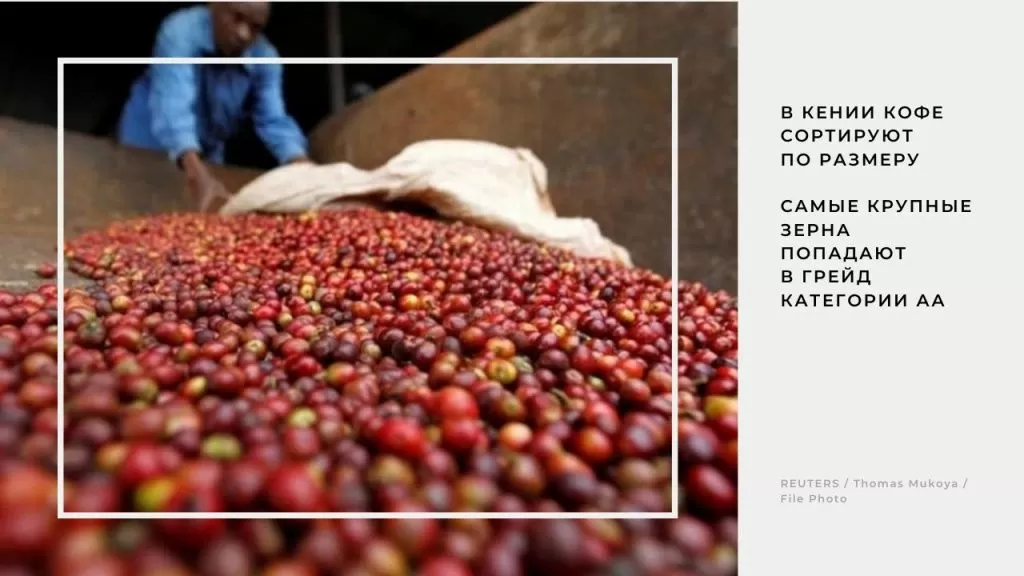
If you are looking for high quality coffee with an interesting flavor profile, intense acidity of ripe berries, citruses and young wine, a round and soft body and a long pleasant aftertaste, coffee from Kenya is what you need!

Main varieties of Arabica
Kenyan Arabica is divided into several varieties. Among them are:
- Ruiruiru is a unique variety whose taste is affected by the roasting time. Prolonged heat treatment promotes maximum flavor development and the appearance of chocolate and cherry flavors. Medium roasting is considered the best option, as it allows you to brew a drink with different taste qualities. Often the first sip is accompanied by a sweet aftertaste with caramel notes; the next sip changes the perception of taste towards tobacco and spicy.
- Kenya AA Ruiruiru - grows on the slopes of Kilimanjara. The finished drink has bread notes, citrus sourness with a subtle aftertaste.
To maximize the taste of coffee from Kenya, you need to know the nuances of its preparation.






